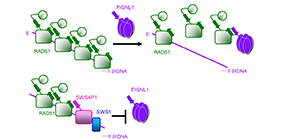
A sign of hope in genome editing and fertility treatment
Researchers clarify how homologous recombination is controlled
A group of researchers from the Institute for Protein Research at Osaka University have clarified that homologous recombination (HR), an exchange of genetic material, is coordinated by mutual interaction and harmonious activity of positive and negative factors in humans and mice, a world first.
HR is a mechanism for repairing DNA damage caused by environmental factors such as radiation and in the sperm/egg formation process. HR plays an essential role in maintaining genome stability in cell proliferation and reproduction; however, when HR acts inappropriately, genome instability is caused in chromosomes, leading to cancer.
Since aberrations in HR genes correlate with cancer susceptibility, it is thought that HR prevents cancer development by repairing DNA double-strand breaks to maintain genome stability. It is also thought that HR is coordinated by RAD51 mediator proteins, such as the breast cancer susceptibility gene BRCA2, which promotes HR and anti-recombinase proteins that inhibit recombination.
The HR proteins BRCA1 and BRCA2, known as tumor suppressor genes, normally play an important role in preventing breast cancer and help repair DNA breaks that can lead to cancer. However, in some people, these tumor suppression genes do not work properly.
Although positive regulators, such as BRCA1 and BRCA2, have been studied, negative factors and the molecular mechanism of HR via interaction between positive and negative regulators had not been understood.
In this study, the team discovered FIGNL1 anti-recombinase and revealed that RAD51 mediator SWSAP1 bound directly to FIGNL1 anti-recombinase and inhibited it, thereby ensuring HR. They also examined SWSAP1 knockout mice to find that sperms and eggs were not produced in the testes and the ovary, respectively. These findings showed that coordination of HR via interaction between SWSAP1 and FIGNL1 played an important role in spermatogenesis and oogenesis.
This team’s achievements will lead to the clarification of the causes of increased cancer predisposition due to inappropriate HR and the development of diagnosis and treatment methods. In addition, the regulation of HR regulators discovered will allow for a wide range of applications, including infertility treatment and genome editing.

Figure 1
The article, “Human RAD51 paralogue, SWSAP1, fosters RAD51 filament by regulating the antirecombinase, FIGNL1 AAA+ ATPase” was published in Nature Communications at DOI: https://doi.org/10.1038/s41467-019-09190-1 .
Related links

